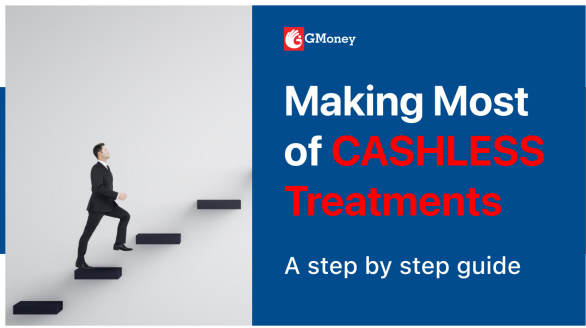Home » A Step-by-Step Guide: Making the Most of Cashless Treatment

Cashless treatment has emerged as a practical option for people seeking medical care without having to make upfront payments. This guide intends to assist clients with a step-by-step method for taking advantage of cashless treatment services supplied by insurance companies or Third Party Administrators (TPAs).
To effectively walk the route of cashless treatment, one must first understand the qualifying requirements established by their insurance provider or Third-Party Administrator (TPA). This entails being acquainted with numerous policy provisions like the sorts of treatments that are covered, hospitals in the network, and the need for pre-authorization for specific medical procedures. It is critical to determine whether your scheduled medical treatment is covered under your insurance.
Furthermore, recognizing the difference between network and non-network hospitals is crucial, since choosing a facility outside your insurer’s network may affect your eligibility for cashless treatments. Familiarising yourself with these requirements will substantially speed up the process of obtaining cashless medical services, ensuring you are well-prepared when a health emergency occurs.

After you’ve decided on a hospital for your treatment, the next critical step is to notify your insurance company or Third-Party Administrator (TPA) of your planned admittance. This critical communication may often be initiated using the channels offered by your insurer, such as a dedicated toll-free number or an online notice form on their official website.
It is critical to complete this step as soon as possible to provide enough time for the essential pre-authorization procedures to finish. In scenarios when direct communication is difficult, hospitals frequently have helpdesks or specialized staff members who can communicate this information to the insurer or TPA on your behalf, especially in emergency situations where time is critical. This early notice is an essential component of the cashless treatment process, paving the way for a more seamless, simplified encounter.
Presenting the proper documents is critical for effectively navigating the cashless treatment channel. Begin with your health insurance card, which serves as a beacon indicating your eligibility for cashless treatments. A valid ID is also required to confirm your identity. The pre-authorization form is an important piece of the a puzzle that must be correctly completed and submitted to commence the cashless request.
This document normally describes the nature of the therapy, the projected expenses, and any other information necessary by the insurance company or TPA for approval. Hospitals frequently assist in compiling and submitting this form, ensuring that all information is appropriately presented in order to speed up the approval process. Having these paperwork ready and in order simplifies the cashless experience by removing any hurdles that might delay your access to critical medical care.
For a planned admission, you must contact your insurance company or TPA well in advance, ideally at least 48 hours before the scheduled admission date. This prior notification gives your insurance provider enough time to conduct any required pre-authorizations, ensuring a smooth transition to cashless treatment. When an emergency admission occurs, prompt action is required due to the urgency of the circumstance.
Hospitals are often prepared to manage the quick communication required for emergency admissions by collaborating directly with your insurance or TPA to obtain the necessary permissions. This cooperation is critical to ensuring your prompt access to care without the extra stress of financial arrangements. Always remember that whether the admission is scheduled or unexpected, the efficiency of the procedure is heavily reliant on timely and clear communication with your insurance provider or TPA.

Selecting the correct hospital for your cashless treatment is an important step in the process. It is critical to confirm if the hospital is a member of your insurance provider’s or TPA’s network, as this assures compliance with your policy’s conditions and can substantially streamline the transaction. Begin by examining your insurer’s list of network hospitals, which is often available on their website or through customer service channels.
Consider the hospital’s expertise, location, and level of care provided in connection to your medical needs. Furthermore, it is important to call the hospital ahead of time to confirm their current network status and question about any unique papers or processes required for cashless treatments. This proactive strategy not only meets your policy requirements, but it also prepares you for a more efficient and stress-free healthcare experience.
Following the first steps of selecting an acceptable hospital and completing the necessary papers, the next critical process is the filing of the cashless request. This is normally handled by the hospital’s administrative or billing department, which will send the pre-authorization form and any other necessary documents to your insurance company or TPA.
It is vital to keep communication channels open with both the hospital and your insurer throughout this time. Following up on the progress of your cashless request is a proactive step that can have a significant impact on the timeliness of approval. Remember that the success of this phase is heavily reliant on the completeness and correctness of the provided papers. To guarantee a smooth and expedited approval process, be sure that all information submitted is consistent with the standards outlined in your insurance policy.
In the cashless treatment procedure, the insured individual’s primary responsibility is to ensure openness and collaboration. This includes giving accurate personal and insurance information to aid in the verification and approval process. It is also critical for the insured to fully comprehend the terms of their policy, communicate effectively with both the hospital and the insurance provider, and quickly provide any needed supplementary information or documents.
On the other side, the hospital serves as a liaison between the insured and the insurance company or TPA. The hospital’s obligations include completing the pre-authorization form, communicating accurate medical information and expected expenses, and organizing the approval procedure for cashless treatment.
To avoid treatment delays, hospital staff must ensure that all documentation is completed and filed on time. The insured and the hospital must collaborate to manage the complexity of the cashless treatment process, with each performing their respective duties to guarantee a flawless experience.
To easily navigate the cashless treatment path, start by thoroughly examining the fine print of your insurance policy. This first step will provide you with an understanding of what is covered, allowing you to prevent surprises later in the process. It is critical to have all of your data organized and accessible, including insurance information and identification.
Proactively contacting your insurer to clarify the progress of your cashless treatment request can help to avoid unexpected delays. Additionally, creating a clear channel of communication between yourself, the insurance provider, and the hospital will speed up the verification and approval processes. To avoid unwanted obstacles, verify that all information given is precise and thorough. These proactive efforts can help to ensure a hassle-free cashless treatment experience.

To navigate the cashless procedure efficiently, you must first grasp the typical hazards. A common mistake is failing to check the validity of their medical treatment under their insurance conditions. This error might result in unanticipated out-of-pocket payments. Furthermore, failure to swiftly notify the insurance company or TPA of the hospital admission, whether scheduled or emergency, might result in delays in getting pre-authorization, limiting your ability to access cashless treatments.
Another error is incorrectly completing the pre-authorization form or failing to provide the required evidence, both of which can have a direct influence on the approval of your cashless request. Mistakes in communication, such as failing to check the hospital’s network status or providing incorrect insurance information to hospital staff, can significantly complicate the procedure. Being aware of these issues and taking proactive actions to avoid them is critical to ensuring a smooth cashless treatment process.
If your cashless request is refused, do not panic. Begin by obtaining any relevant bills and paperwork about your medical care. These will be required when filing a reimbursement claim with your insurance carrier to ensure that you may recover the expenditures incurred. Furthermore, it is recommended that you carefully analyze the grounds for your request’s refusal. Understanding why can help you determine if the denial was caused by a misunderstanding or a lack of knowledge.
Armed with this knowledge, you have the ability to appeal the judgment. Contact your insurance carrier or TPA to appeal the refusal, and include any extra data or explanation that may help your case. This proactive approach can frequently result in a reconsideration of your request and, in some cases, reversal of the decision, allowing for a more favorable conclusion.
About GMoney Seven Sigma:
At GMoney Seven Sigma, we’re revolutionizing Revenue Cycle Management (RCM) services in India. Our mission is to simplify and enhance cashless transactions, ensuring that hospitals can focus on what they do best – providing excellent patient care. Our dedication to seamless service and customer satisfaction drives us to deliver top-notch solutions tailored to the unique needs of the healthcare industry.
RCM Services:
Transform Your Hospital’s Financial Health with GMoney’s RCM Services:
Our comprehensive RCM solution is designed to address the challenges faced by hospitals today. From streamlining billing and coding to efficient claims processing and payment collection, we’ve got you covered. Our team of experts collaborates with you to eliminate bottlenecks, boost efficiency, and maximize reimbursements. We manage Insurance / TPAs, Ayushman Bharat, CGHS, SGHS, ECHS, Most Govt and state run health schemes.
Why Choose GMoney’s RCM Service?
Specialized in Delay and Denied Claims Processing:
We understand the frustration and financial strain caused by delayed and denied claims. GMoney specializes in tackling these issues ensuring that your hospital recovers stuck claims .
Empower Your Hospital with GMoney Seven Sigma:
Embrace a more efficient and profitable future with GMoney’s RCM services. Our dedicated team is here to empower your hospital to navigate the complexities of healthcare finance successfully. Don’t let financial challenges hold your hospital back. Contact our relationship managers today for a discussion on how GMoney Seven Sigma can assist you.
Follow us
Reach us
Mumbai HO
GMoney Pvt. Ltd.
315, 215 Atrium,
Next to Courtyard by Marriott,,
A.K. Road, Andheri East,
Mumbai - 400093
Ph : +91 86570 00105, +91 72089 60444
Quick Links
Bengaluru
GMoney Technologies Pvt. Ltd.
Oyo Work Spaces, Umiya Emporium,
Opposite Forum Mall, Hosur Rd,
Koramangala, Bengaluru,
Karnataka 560029
Ph : +91 89717 34815
Delhi
GMoney Technologies Pvt. Ltd.
Berry Co Works, 1E/3,
Jhandewalan extension,
Next to jhandewalan metro station
gate no. 2 Barakhambha Road,
New Delhi, Delhi 110001
Ph : +91 97116 26832
Pune
GMoney Technologies Pvt. Ltd.
91 Spring Board, Sky Loft,
Creaticity Mall, Off, Airport Rd,
opposite Golf Course, Shastrinagar,
Yerawada, Pune,
Maharashtra 411006
Ph : +91 84250 28758
Chandigarh
GMoney Technologies Pvt. Ltd.
SCO no. 292,
First Floor, Sector 35D,
Chandigarh
Ph : +91 84279 82012
Jaipur
GMoney Pvt. Ltd.
CODESKK Civil Tower,121 122,
Pandit TN Mishra Marg,
Santhosh Nagar, Nirman Nagar,
Jaipur – 302019
Ahmedabad
GMoney Pvt. Ltd.
22nd Floor, B Block,
Westgate By True Value,
Nr. YMCA Club, SG Highway,
Ahmedabad – 380051
Hyderabad
GMoney Pvt. Ltd.
Dwaraka Pride,
Plot no. 4/1, Survey No. 64,
Huda Techno Enclave, Madhapur,
Hyderabad (Telangana) – 500081
Chennai
GMoney Pvt. Ltd.
DBS Business Center, 31A,
Cathedral Garden Rd, Badrikari, Tirumurthy Nagar, Nungambakkam, Chennai, Tamil
Nadu – 600 034
Mumbai HO
GMoney Pvt. Ltd.
315, 215 Atrium,
Next to Courtyard by Marriott,,
A.K. Road, Andheri East,
Mumbai - 400093
Ph : +91 86570 00105, +91 72089 60444
Bengaluru
GMoney Pvt. Ltd.
Oyo Work Spaces,
Umiya Emporium,
Opp. Forum Mall, Hosur Rd,
Koramangala, Bengaluru,
Karnataka - 560029
Ph : +91 72089 60444
Pune
GMoney Pvt. Ltd.
91 Spring Board, Sky Loft,
Creaticity Mall, Airport Rd,
Opp. Golf Course, Shastrinagar,
Yerawada, Pune,
Maharashtra - 411006
Ph : +91 72089 60444
Delhi
GMoney Pvt. Ltd.
Berry Co Works, 1E/3,
Jhandewalan extension,
Gate no. 2 Barakhambha Road,
New Delhi, Delhi - 110001
Ph :
+91 72089 60444
Chandigarh
GMoney Pvt. Ltd.
SCO No. 292,
First Floor, Sector 35D,
Chandigarh - 160022
Ph : +91 72089 60444
Ahmedabad
GMoney Pvt. Ltd.
22nd Floor, B Block,
Westgate By True Value,
Nr. YMCA Club, SG Highway,
Ahmedabad - 380051
Hyderabad
GMoney Pvt. Ltd.
Dwaraka Pride,
Plot no. 4/1, Survey No. 64,
Huda Techno Enclave, Madhapur,
Hyderabad (Telangana) - 500081
Jaipur
GMoney Pvt. Ltd.
CODESKK Civil Tower,121 122,
Pandit TN Mishra Marg,
Santhosh Nagar, Nirman Nagar,
Jaipur - 302019
Chennai
GMoney Pvt. Ltd.
DBS Business Center, 31A,
Cathedral Garden Rd, Badrikari,
Tirumurthy Nagar,Nungambakkam, Chennai,
Tamil
Nadu - 600 034
Pune | Mumbai | New Delhi | Kolkata | Chennai | Navi Mumbai| Bengaluru | Ahmedabad | Nagpur | Hyderabad | Jaipur | Lucknow | Bhopal | Bhubaneswar | Nashik | Indore | Ghaziabad | Kanpur | Amritsar | Vasai | Noida | Gurugram | Chandigarh | Ranchi | Cuttack | Thane | Kalyan | Jalandhar | Kolhapur | Visakhapatnam | Chakan| Greater Noida | Wagholi | Raipur | Panvel | Belgaum | Mohali | Bhiwandi | Talegaon | Coimbatore | Palghar | Mumbra | Sangli | Surat | Durgapur | Ludhiana | Kochi | Agra | Ahmednagar | Ajmer | Akola | Aurangabad | Baroda | Beed | Rewari | Patiala | Vellore | Ranjangaon | Nanded | Nellore | Panipat | Panjim | Madurai | Mysore | Mangalore | Korba | Mathura | Kalaburagi | Jalgaon | Kharar | Guwahati | Kollam | Jamshedpur | Gwalior | Saswad | Solapur | Varanasi | Salem | Sambalpur | Jodhpur | Hubli | Panchkula | Faridabad | Amravati | Ayodhya | Badlapur | Dehradun | Parbhani | Ujjain | Udaipur | Tiruchirappalli | Srinagar | Shimla | Secunderabad | Ratnagiri | Pandharpur | Ananthapuram | Buldhana | Hadapsar | Baramati | Chittoor | Darjeeling | Dhule | Fatehpur | Gandhinagar | Haridwar | Gorakhpur | Jhansi | Kanchipuram | Kartarpur | Kurukshetra | Pondicherry | Prayagraj | Bharuch | Bhusawal | Bathinda | Pathankot | Nandurbar | Niphad | Kolar | Ambala | Kota | Pendurthi | Jabalpur | Palwal | Bhilai | Bhiwani | Bilaspur | Patna | Rohtak | Phagwara | Malegaon | Vijayawada | Bikaner | Chiplun | Darbhanga | Roorkee | Bhor | Rajahmundry | Margao | Alwar | Dhanbad | Bulandshahr | Aluva | Mulshi | Davanagere | Kapurthala | Anantapur | Loni | Latur | Gondia | Chhindwara | Chandrapur | Dharmapuri-TN | Faridkot | Dharwad | Daund | Chaksu | Bareilly | Kakinada | Haldwani | Doddaballapur | Dindori-MH | Bagru | Kudus | Kozhikode | Gurdaspur | Bokaro | Berhampur | Batala | Barrackpore | Ramgarh | Meerut | Bassi | Dera Bassi | Howrah | Karjat Raigarh | Thiruvananthapuram | Bheemunipatnam | Ambegoan | Allahabad | Aligarh | Alappuzha | Tirupathi | Thoppumpady | Srikakulam | Siliguri | Rourkela | Mirzapur | Gadag | Bellary | Tumkur | Sonipat | Hoshangabad | Junnar | Jalna | Hisar | Karnal | Kottayam | Muzzafarnagar | Ramnagara | Thrissur | Bahadurgarh | Balasore | Baraut | Dhar | Ernakulam | Gadhinglaj | Chikodi | Vaniyambadi | Kamothe |